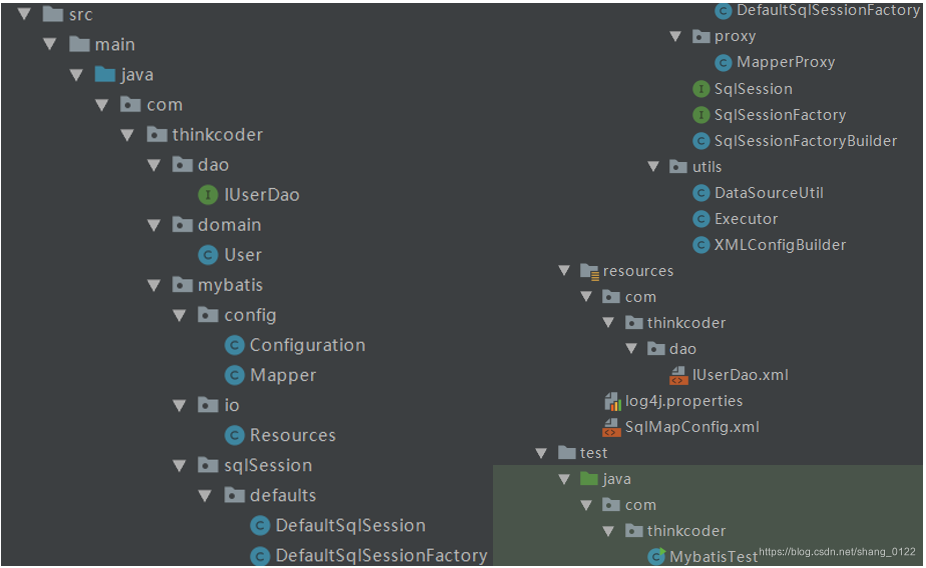一、项目结构图总览

二、前期开发准备
2.1创建Maven工程



点击finish即可

2.2pom.xml文件导入相关坐标
<?xml version="1.0" encoding="UTF-8"?>
<project xmlns="http://maven.apache.org/POM/4.0.0"
xmlns:xsi="http://www.w3.org/2001/XMLSchema-instance"
xsi:schemaLocation="http://maven.apache.org/POM/4.0.0 http://maven.apache.org/xsd/maven-4.0.0.xsd">
<modelVersion>4.0.0</modelVersion>
<groupId>com.thinkcoder</groupId>
<artifactId>selfmybatis</artifactId>
<version>1.0.0</version>
<!--打包方式jar包-->
<packaging>jar</packaging>
<!--mysql驱动-->
<dependencies>
<dependency>
<groupId>mysql</groupId>
<artifactId>mysql-connector-java</artifactId>
<version>5.1.6</version>
</dependency>
<!-- 操作日志-->
<dependency>
<groupId>org.apache.logging.log4j</groupId>
<artifactId>log4j</artifactId>
<version>2.12.1</version>
</dependency>
<!--解析xml文件-->
<dependency>
<groupId>dom4j</groupId>
<artifactId>dom4j</artifactId>
<version>1.6.1</version>
</dependency>
<dependency>
<groupId>jaxen</groupId>
<artifactId>jaxen</artifactId>
<version>1.1.6</version>
</dependency>
</dependencies>
</project>
2.3建立数据库操作的配置文件
建表的sql脚本
CREATE TABLE `user` (
`name` char(4) DEFAULT NULL,
`pwd` varchar(255) DEFAULT NULL,
`id` int(255) DEFAULT NULL
) ENGINE=InnoDB DEFAULT CHARSET=utf8;
User类:属性与数据库表字段名称保持一致
- 利用了ORM思想:Object Relational Mapping对象关系映射,把实体类的属性和数据库表对应起来,操作实体类就实现操作数据库表
public class User {
private Integer id;
private String name;
private String pwd;
//getter和setter方法
public Integer getId() {return id;}
public void setId(Integer id) {this.id = id;}
public String getName() {return name;}
public void setName(String name) {this.name = name;}
public String getPwd() {return pwd;}
public void setPwd(String pwd) {this.pwd = pwd;}
//重写toString方法
@Override
public String toString() {
return "User{" +
"id=" + id +
", name='" + name + '\'' +
", pwd='" + pwd + '\'' +
'}';
}
}
IUserDao接口:操作数据库的接口
public interface IUserDao {
//查询所有操作
List<User> findAll();
}
SqlMapConfig.xml文件:配置连接数据库信息及指定映射配置文件位置
<?xml version="1.0" encoding="UTF-8"?>
<!--mybatis的主配置文件-->
<configuration>
<!--配置环境-->
<environments default="mysql">
<!--配置mysql的环境-->
<environment id="mysql">
<!--配置事务的类型-->
<transactionManager type="JDBC"></transactionManager>
<!--配置数据源(连接池)-->
<dataSource type="POOLED">
<!--配置连接数据库的4个基本信息-->
<property name="driver" value="com.mysql.jdbc.Driver"/>
<property name="url" value="jdbc:mysql://localhost:3306/selfproj"/>
<property name="username" value="root"/>
<property name="password" value="123456"/>
</dataSource>
</environment>
</environments>
<!--指定映射配置文件的位置,映射配置文件指的是每个dao独立的配置文件-->
<mappers>
<mapper resource="com/thinkcoder/dao/IUserDao.xml"/>
</mappers>
</configuration>
IUserDao.xml文件:配置方法映射的sql语句及返回结果类型
<?xml version="1.0" encoding="UTF-8"?>
<mapper namespace="com.thinkcoder.dao.IUserDao">
<!--配置查询所有记录--><!--id为方法的名称-->
<select id="findAll" resultType="com.thinkcoder.domain.User">
select * from user
</select>
</mapper>
三、自定义MaBatis框架主要类总览
为了搞清主要类之间的调用关系,画了一个时序图,UML可是架构师的利器,要善于使用

上面的图是重点:下面按照上图调用关系用代码实现
四、自定义MyBatis框架实现
测试类(client)
public class MybatisTest {
public static void main(String[] args) throws IOException {
//1.读取配置文件
InputStream in = Resources.getResourceAsStream("SqlMapConfig.xml");
//2.创建SqlSessionFactory工厂
SqlSessionFactoryBuilder builder = new SqlSessionFactoryBuilder();
SqlSessionFactory factory = builder.build(in);
//3.使用工厂生产SqlSession对象
SqlSession session = factory.openSession();
//4.使用SqlSession创建Dao接口的代理对象,因为IUserDao接口没有实现类
IUserDao userDao = session.getMapper(IUserDao.class);
//5.使用代理对象执行方法
List<User> users = userDao.findAll();
for (User user:users){
System.out.println(user);
}
//6.释放资源
session.close();
in.close();
}
}
Resources类
- 读取配置文件
public class Resources {
/**
* @Description:根据传入的参数,获取一个字节输入流
* @Author: Think-Coder
* @Param :filePath
*
* 在实际开发中读取配置文件
* 1.使用类加载器,但是有要求:a文件不能过大,b文件必须在类路径下(classpath)
* 2.使用ServletContext的getRealPath()
**/
public static InputStream getResourceAsStream(String filePath){
return Resources.class.getClassLoader().getResourceAsStream(filePath);
}
}
SqlSessionFactoryBuilder
- 构建者模式创建SqlSessionFactroy工厂
public class SqlSessionFactoryBuilder {
/**
* @Description:根据参数的字节输入流来构建一个SqlSessionFactory工厂
* @Author: Think-Coder
* @Param :config
**/
public SqlSessionFactory build(InputStream config) {
//解析流需要解析xml工具类
Configuration conf = XMLConfigBuilder.loadConfiguration(config);
return new DefaultSqlSessionFactory(conf);
}
}
XMLConfigBuilder类
- dom4j+xpath技术解析XML文件
public class XMLConfigBuilder {
/**
* 解析主配置文件,把里面的内容填充到DefaultSqlSession所需要的地方
* 使用的技术:
* dom4j+xpath
*/
public static Configuration loadConfiguration(InputStream config){
try{
//定义封装连接信息的配置对象(mybatis的配置对象)
Configuration cfg = new Configuration();
//1.获取SAXReader对象
SAXReader reader = new SAXReader();
//2.根据字节输入流获取Document对象
Document document = reader.read(config);
//3.获取根节点
Element root = document.getRootElement();
//4.使用xpath中选择指定节点的方式,获取所有property节点
List<Element> propertyElements = root.selectNodes("//property");
//5.遍历节点
for(Element propertyElement : propertyElements){
//判断节点是连接数据库的哪部分信息
//取出name属性的值
String name = propertyElement.attributeValue("name");
if("driver".equals(name)){
//表示驱动
//获取property标签value属性的值
String driver = propertyElement.attributeValue("value");
cfg.setDriver(driver);
}
if("url".equals(name)){
//表示连接字符串
//获取property标签value属性的值
String url = propertyElement.attributeValue("value");
cfg.setUrl(url);
}
if("username".equals(name)){
//表示用户名
//获取property标签value属性的值
String username = propertyElement.attributeValue("value");
cfg.setUsername(username);
}
if("password".equals(name)){
//表示密码
//获取property标签value属性的值
String password = propertyElement.attributeValue("value");
cfg.setPassword(password);
}
}
//取出mappers中的所有mapper标签,判断他们使用了resource还是class属性
List<Element> mapperElements = root.selectNodes("//mappers/mapper");
//遍历集合
for(Element mapperElement : mapperElements){
//判断mapperElement使用的是哪个属性
Attribute attribute = mapperElement.attribute("resource");
if(attribute != null){
System.out.println("使用的是XML");
//表示有resource属性,用的是XML
//取出属性的值
String mapperPath = attribute.getValue();//获取属性的值"com/thinkcoder/dao/IUserDao.xml"
//把映射配置文件的内容获取出来,封装成一个map
Map<String, Mapper> mappers = loadMapperConfiguration(mapperPath);
//给configuration中的mappers赋值
cfg.setMappers(mappers);
}
}
//返回Configuration
return cfg;
}catch(Exception e){
throw new RuntimeException(e);
}finally{
try {
config.close();
}catch(Exception e){
e.printStackTrace();
}
}
}
/**
* 根据传入的参数,解析XML,并且封装到Map中
* @param mapperPath 映射配置文件的位置
* @return map中包含了获取的唯一标识(key是由dao的全限定类名和方法名组成)
* 以及执行所需的必要信息(value是一个Mapper对象,里面存放的是执行的SQL语句和要封装的实体类全限定类名)
*/
private static Map<String,Mapper> loadMapperConfiguration(String mapperPath)throws IOException {
InputStream in = null;
try{
//定义返回值对象
Map<String,Mapper> mappers = new HashMap<String,Mapper>();
//1.根据路径获取字节输入流
in = Resources.getResourceAsStream(mapperPath);
//2.根据字节输入流获取Document对象
SAXReader reader = new SAXReader();
Document document = reader.read(in);
//3.获取根节点
Element root = document.getRootElement();
//4.获取根节点的namespace属性取值
String namespace = root.attributeValue("namespace");//是组成map中key的部分
//5.获取所有的select节点
List<Element> selectElements = root.selectNodes("//select");
//6.遍历select节点集合
for(Element selectElement : selectElements){
//取出id属性的值 组成map中key的部分
String id = selectElement.attributeValue("id");
//取出resultType属性的值 组成map中value的部分
String resultType = selectElement.attributeValue("resultType");
//取出文本内容 组成map中value的部分
String queryString = selectElement.getText();
//创建Key
String key = namespace+"."+id;
//创建Value
Mapper mapper = new Mapper();
mapper.setQueryString(queryString);
mapper.setResultType(resultType);
//把key和value存入mappers中
mappers.put(key,mapper);
}
return mappers;
}catch(Exception e){
throw new RuntimeException(e);
}finally{
in.close();
}
}
}
Configuration类
- 由XMLConfigBuilder解析xml文件返回Configuration对象
/**
* 自定义MyBatis的配置类
* @ClassName Configuration
* @Author thinkcoder
* @Data 2020/5/20 11:20
* @Version 1.0
*/
public class Configuration {
private String driver;
private String url;
private String username;
private String password;
//String保存的是全限定类名加方法名,com.thinkcoder.IUserDao.findAll
//Mapper存的是返回的实体类的全限定类名,com.thinkcoder.domain.User
//及sql语句
//通过String可以确定Mapper
private Map<String, Mapper> mappers;
//getter和setter方法
public Map<String, Mapper> getMappers() {return mappers;}
public void setMappers(Map<String, Mapper> mappers) {this.mappers = mappers;}
public String getDriver() {return driver;}
public void setDriver(String driver) {this.driver = driver;}
public String getUrl() {return url;}
public void setUrl(String url) {this.url = url;}
public String getUsername() {return username;}
public void setUsername(String username) {this.username = username;}
public String getPassword() {return password;}
public void setPassword(String password) {this.password = password;}
}
Mapper类
/**
* 用于封装执行的SQL语句和结果类型的全限定类名
* @ClassName Mapper
* @Author think-coder
* @Data 2020/5/20 11:23
* @Version 1.0
*/
public class Mapper {
private String queryString;//SQL
private String resultType;//实体类的全限定类名
public String getResultType() {
return resultType;
}
public void setResultType(String resultType) {
this.resultType = resultType;
}
public String getQueryString() {
return queryString;
}
public void setQueryString(String queryString) {
this.queryString = queryString;
}
}
SqlSessionFactory接口:
public interface SqlSessionFactory {
/**
* @Description:用于打开一个新的SqlSession对象
**/
SqlSession openSession();
}
DefaultSqlSessionFactory类
- 实现SqlSessionFactory接口,生成sqlsession对象
/**
* @ClassName DefaultSqlSessionFactory
* @Author Think-Coder
* SqlSessionFactory接口的实现类
*/
public class DefaultSqlSessionFactory implements SqlSessionFactory {
private Configuration conf;
public DefaultSqlSessionFactory(Configuration conf){
this.conf = conf;
}
/**
* @Description:用于创建一个新的操作数据库对象
* @Return :SqlSession
**/
public SqlSession openSession() {
return new DefaultSqlSession((conf));
}
}
SqlSession接口
- 和数据库交互的核心类
/**
* 自定义Mybatis中和数据库交互的核心类
* 里面可以创建dao接口的代理对象
* @Author Think-Coder
*/
public interface SqlSession {
/**
* @Description:根据参数创建一个代理对象
* @Param :daoInterfaceClass dao的接口字节码
**/
<T> T getMapper(Class<T> daoInterfaceClass);
/**
* 释放资源
*/
void close();
}
DefaultSqlSession类
- 实现SqlSession接口
/**
* @ClassName DefaultSqlSession
* @Author Think-Coder
* SqlSession接口的实现类
*/
public class DefaultSqlSession implements SqlSession {
private Configuration conf;
private Connection connection;
public DefaultSqlSession(Configuration conf){
this.conf = conf;
connection = DataSourceUtil.getConnection(conf);
}
/**
* @Description:用于创建代理对象
* @Param :daoInterfaceClass dao的接口字节码
**/
public <T> T getMapper(Class<T> daoInterfaceClass) {
return (T)Proxy.newProxyInstance(daoInterfaceClass.getClassLoader(),
new Class[]{daoInterfaceClass},new MapperProxy(conf.getMappers(),connection));
}
/**
* @Description:释放资源
**/
public void close() {
if(connection != null){
try {
connection.close();
} catch (SQLException e) {
e.printStackTrace();
}
}
}
}
DataSourceUtil工具类
- 用于创建数据源
//用于创建数据源的工具类
public class DataSourceUtil {
//用于获取一个连接
public static Connection getConnection(Configuration conf){
try{
Class.forName(conf.getDriver());
return DriverManager.getConnection(conf.getUrl(),conf.getUsername(),conf.getPassword());
}catch (Exception e){
throw new RuntimeException(e);
}
}
}
MapperProxy类
- 用于增强原对象IUserDao接口,增强方法为selectList方法
public class MapperProxy implements InvocationHandler {
//map的key是全限定类名+方法名
private Map<String, Mapper> mappers;
private Connection conn;
public MapperProxy(Map<String,Mapper> mappers,Connection conn){
this.mappers = mappers;
this.conn = conn;
}
//用于对方法的增强,我们的增强其实就是调用selectList方法
public Object invoke(Object proxy, Method method, Object[] args) throws Throwable {
//1.获取方法名
String methodName = method.getName();
//2.获取方法所在类的名称
String className = method.getDeclaringClass().getName();
//3.组合key
String key = className+"."+methodName;
//4.获取mappers中的Mapper对象
Mapper mapper = mappers.get(key);
//5.判断是否有mapper
if (mapper == null) {
throw new IllegalArgumentException("传入参数有误");
}
//6.调用工具类执行查询所有
return new Executor().selectList(mapper,conn);
}
}
Executor 工具类
//负责执行SQL语句,并且封装结果集
public class Executor {
public <E> List<E> selectList(Mapper mapper, Connection conn) {
PreparedStatement pstm = null;
ResultSet rs = null;
try {
//1.取出mapper中的数据
String queryString = mapper.getQueryString();//select * from user
String resultType = mapper.getResultType();//com.thinkecoder.domain.User
Class domainClass = Class.forName(resultType);
//2.获取PreparedStatement对象
pstm = conn.prepareStatement(queryString);
//3.执行SQL语句,获取结果集
rs = pstm.executeQuery();
//4.封装结果集
List<E> list = new ArrayList<E>();//定义返回值
while(rs.next()) {
//实例化要封装的实体类对象
E obj = (E)domainClass.newInstance();
//取出结果集的元信息:ResultSetMetaData
ResultSetMetaData rsmd = rs.getMetaData();
//取出总列数
int columnCount = rsmd.getColumnCount();
//遍历总列数
for (int i = 1; i <= columnCount; i++) {
//获取每列的名称,列名的序号是从1开始的
String columnName = rsmd.getColumnName(i);
//根据得到列名,获取每列的值
Object columnValue = rs.getObject(columnName);
//给obj赋值:使用Java内省机制(借助PropertyDescriptor实现属性的封装)
PropertyDescriptor pd = new PropertyDescriptor(columnName,domainClass);//要求:实体类的属性和数据库表的列名保持一种
//获取它的写入方法
Method writeMethod = pd.getWriteMethod();
//把获取的列的值,给对象赋值
writeMethod.invoke(obj,columnValue);
}
//把赋好值的对象加入到集合中
list.add(obj);
}
return list;
} catch (Exception e) {
throw new RuntimeException(e);
} finally {
release(pstm,rs);
}
}
//释放资源
private void release(PreparedStatement pstm,ResultSet rs){
if(rs != null){
try {
rs.close();
}catch(Exception e){
e.printStackTrace();
}
}
if(pstm != null){
try {
pstm.close();
}catch(Exception e){
e.printStackTrace();
}
}
}
}
五、运行结果及总结
上述实现了查询数据库功能
User{id=1, name='张三', pwd='123'}
User{id=2, name='李四', pwd='128'}
Process finished with exit code 0
上述代码按照去除了Mybatis的依赖,从测试类开始一步一步搭建起来的,读者也可以自己练习一下






















 2084
2084











 被折叠的 条评论
为什么被折叠?
被折叠的 条评论
为什么被折叠?










